- Contents
- What is SHA?
- What is SHIF?
- Key Findings
- Demographic Overview
- Income
- Awareness and Knowledge Levels
- Source of information
- Do you understand the purpose of SHIF
- The Goal of SHIF
- Expectations of SHIF
- Enrolled to SHIF
- Reasons for not registering to SHIF
- Usage and Experience of SHIF Among Enrolled Participants
- Healthcare services to be prioritized under SHIF
- SHIF challenges
- Methodology/About this Survey
The Social Health Authority (SHA) and the Social Health Insurance Fund (SHIF) are part of Kenya’s healthcare reform aimed at achieving Universal Health Coverage (UHC) by replacing the National Health Insurance Fund (NHIF).
What is SHA?
The Social Health Authority (SHA) is the government agency established to oversee and regulate Kenya’s new healthcare financing system. It replaces the National Health Insurance Fund (NHIF) and is responsible for managing the new health insurance structure under the Social Health Insurance Fund (SHIF). Employers were required to register their employees and their dependents with SHA through the SHA Employer Portal by October 1, 2024. The final date for NHIF admissions was September 30, 2024.
What is SHIF?
The Social Health Insurance Fund (SHIF) is the primary health insurance scheme under SHA. It is designed to ensure that all Kenyans, including those in the informal sector and vulnerable groups, have access to affordable and quality healthcare.
To better understand the public perception of Kenya’s new healthcare reforms, GeoPoll recently conducted a survey on SHA /SHIF. The study sought to assess awareness, understanding, and attitudes toward these initiatives, which are set to replace the National Health Insurance Fund (NHIF) as part of the government’s Universal Health Coverage (UHC) strategy.
Key Findings
- Awareness and Knowledge Levels
- Perception of Accessibility and Affordability
- SHA/SHIF Usage
- SHA/SHIF Challenges
Demographic Overview
The survey gathered feedback from 961 respondents in Kenya. The participants are of age 18 years old and above, with the largest share being between 25-35 years old (59%), and comprised 52% female and 48% male. A majority, (38%) are college degree holders. In addition, 73% stated that they reside in urban areas whereas 27% live in rural areas.
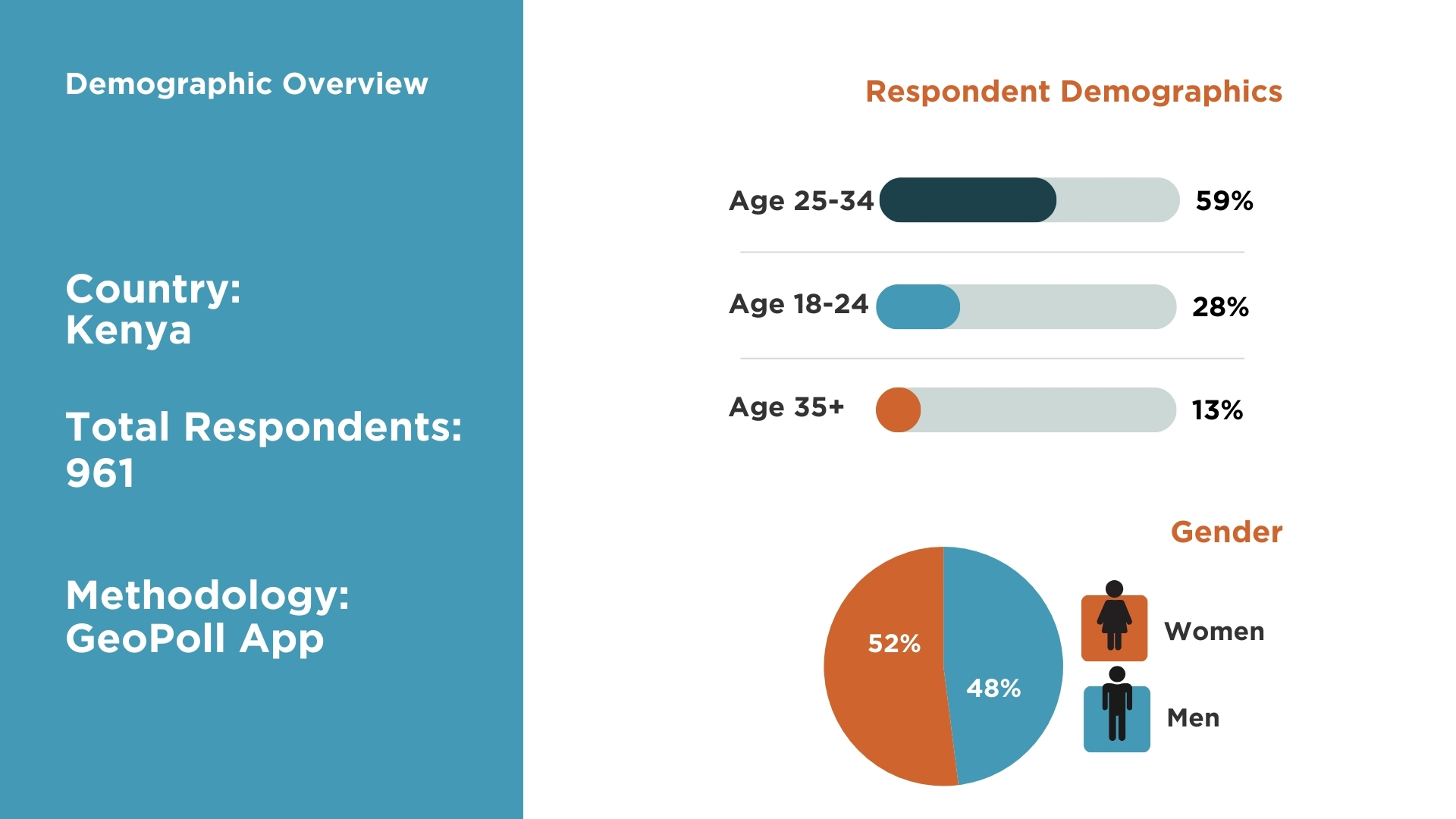
Income
The survey results indicated that a significant portion of respondents (34%) earn less than Kes. 10,000, followed closely by 31% who fall within the Kes. 10,001 – Kes. 30,000 income bracket. Additionally, 14% earn between Kes. 30,001 and Kes. 50,000, while 12% report earnings of Kes. 50,001 – Kes. 100,000. A smaller percentage, 7%, earn between Kes. 100,001 and Kes. 250,000, with only 4% making more than Kes. 250,000.
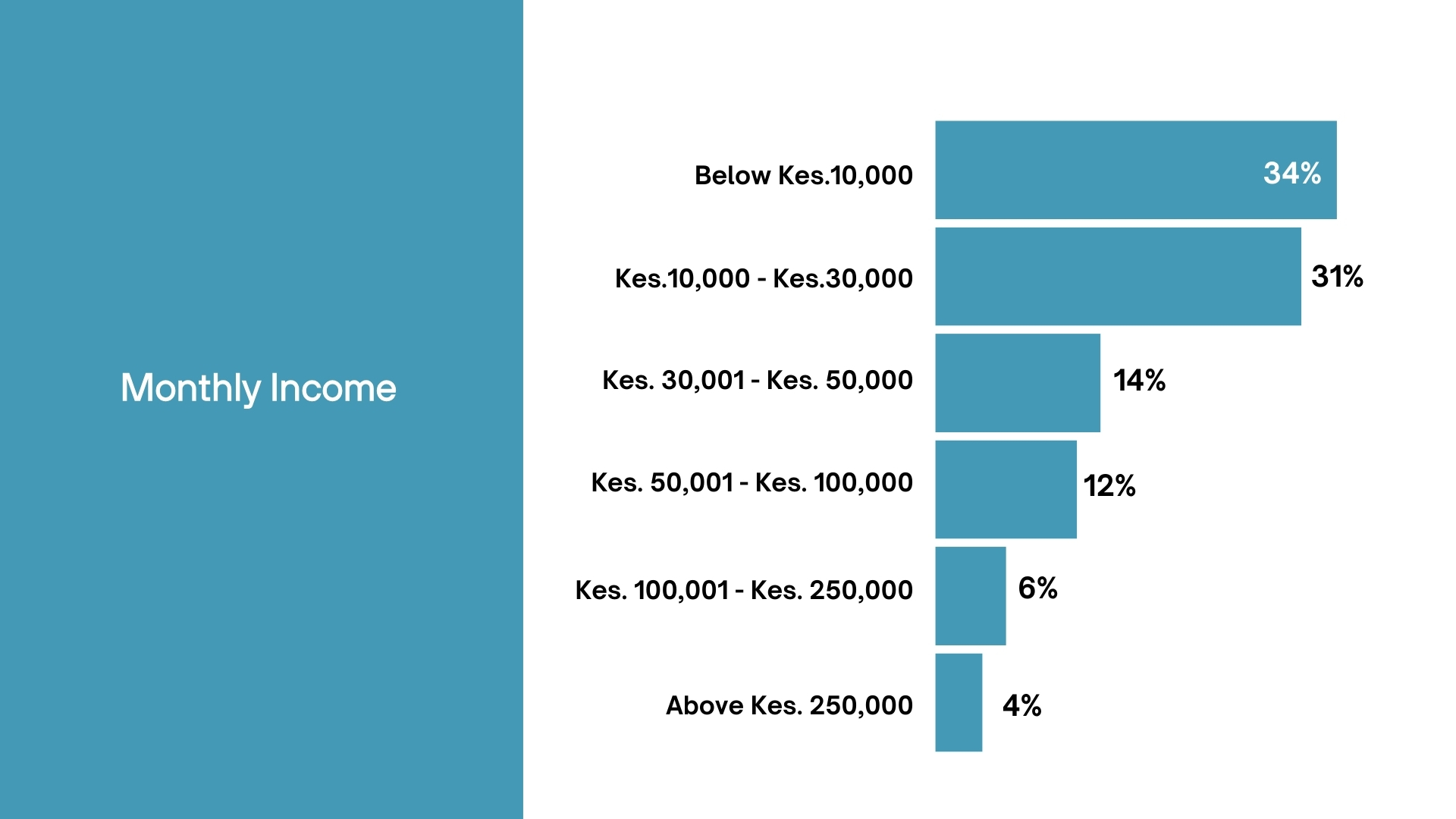
Awareness and Knowledge Levels
Our survey showed that 95% of respondents are aware of SHA and SHIF, while 4% have never heard of them. Among those who are familiar with SHA and SHIF, 34% have extensive knowledge, 33% have some knowledge, 26% have limited knowledge, and 4% have no knowledge at all.
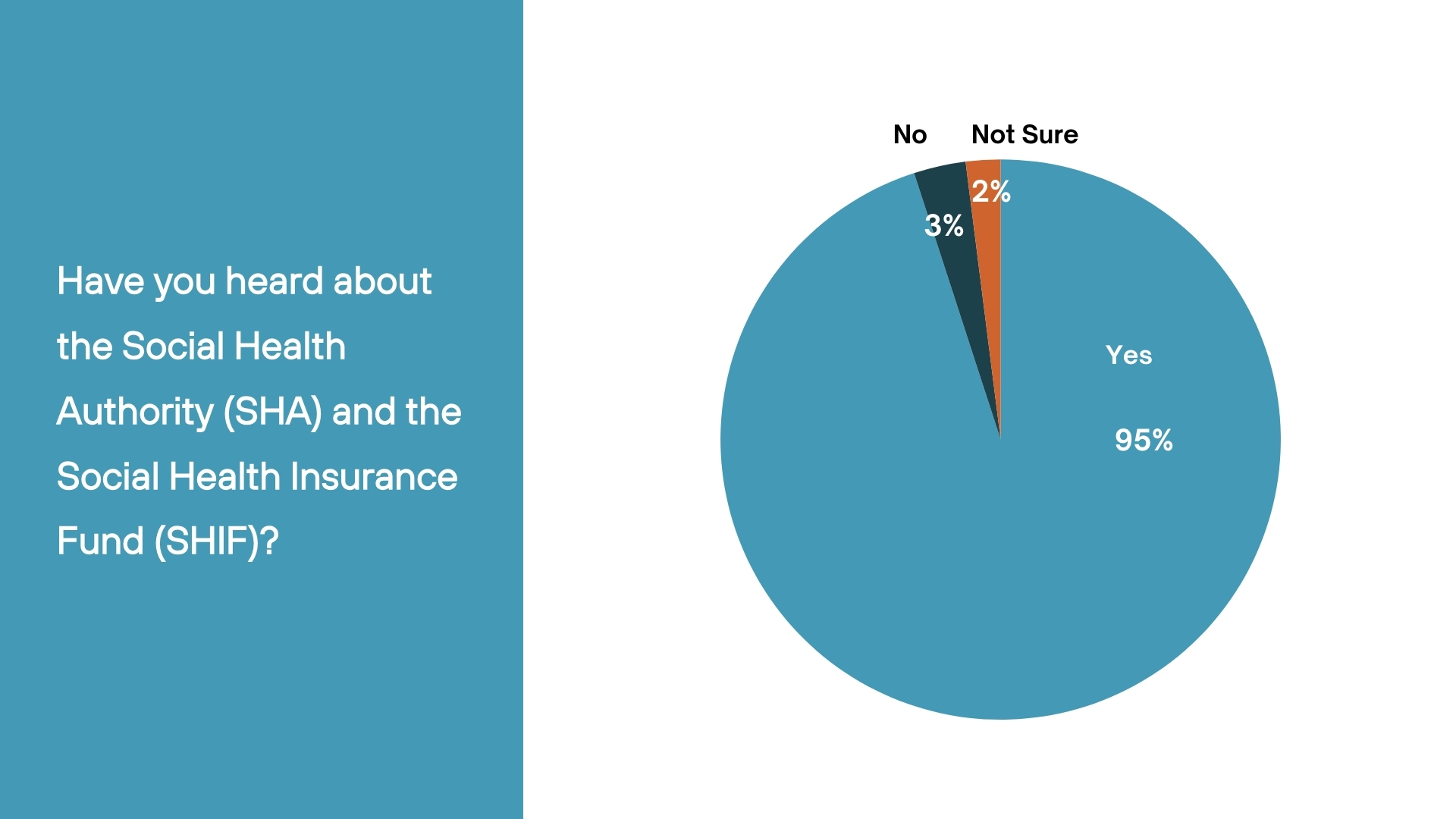
Source of information
Television is the primary source of information for respondents, with 27% indicating that they rely on it for updates about SHA and SHIF. Social media follows closely behind as the main source of information for 25% of participants. Radio is also a significant channel, with 15% of respondents learning about SHA and SHIF through it. Furthermore, 13% of participants reported obtaining information from official government websites. Word of mouth is another important source, with 10% of respondents hearing about SHA and SHIF through informal conversations, while healthcare providers, such as doctors and nurses, are influential sources for another 10% of participants.
This distribution highlights a diverse mix of traditional and digital communication channels that contribute to public awareness of SHA and SHIF.
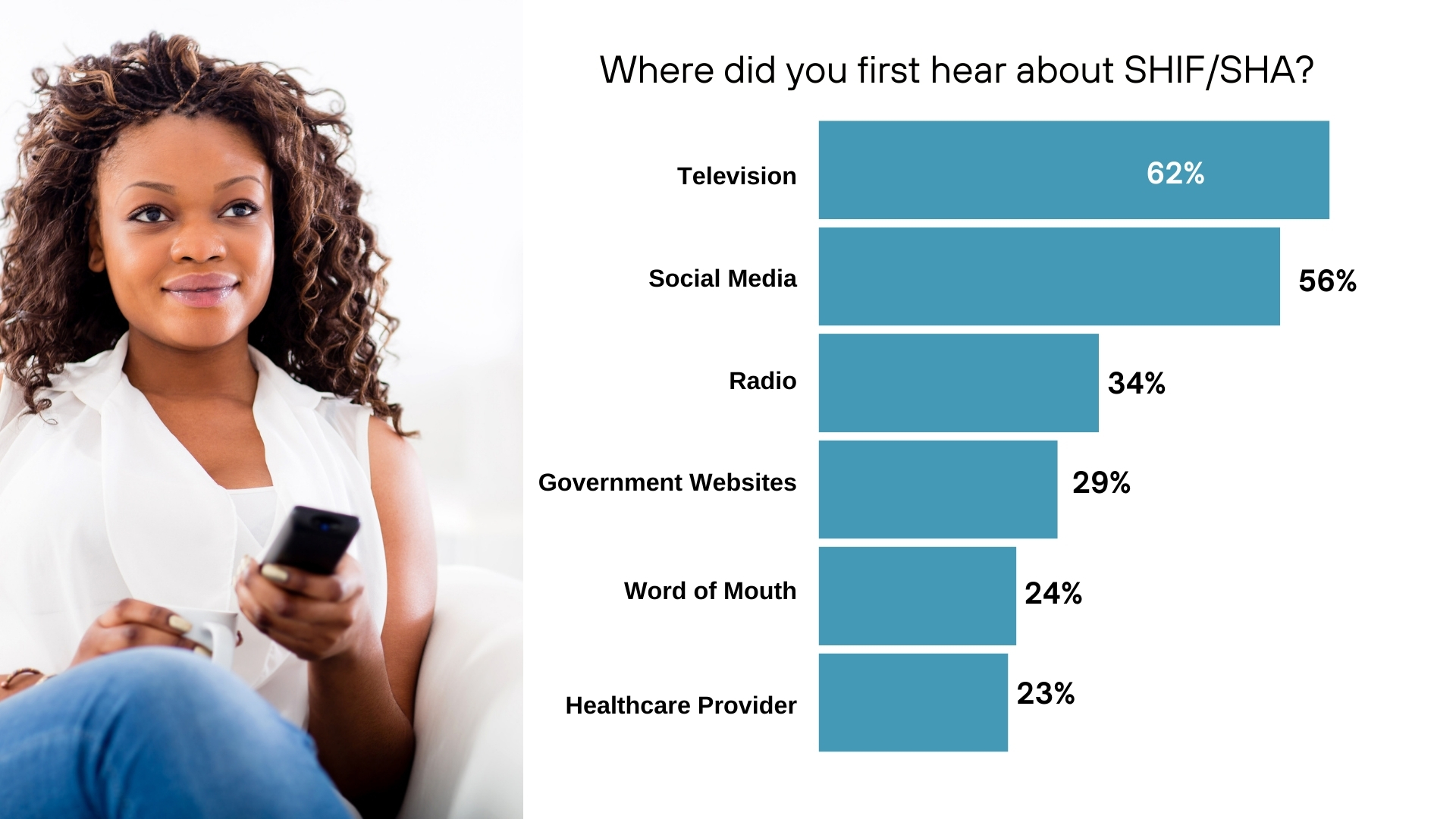
Do you understand the purpose of SHIF
A significant portion of respondents, 38%, indicated that they have a somewhat good understanding of SHIF. This suggests that while they are familiar with the concept, they may not fully grasp all its details and nuances. Additionally, 27% reported having a very good understanding of SHIF, indicating that they are highly knowledgeable about how the fund works, its benefits, and its role in the healthcare system.
On the other hand, 27% of respondents acknowledged having a limited understanding of SHIF. This could indicate a lack of clear or detailed information, or possibly confusion regarding its functions and services. Additionally, an 8% minority stated that they do not understand SHIF at all, highlighting a significant gap in knowledge or awareness. This gap could result from factors such as limited access to information or communication barriers.
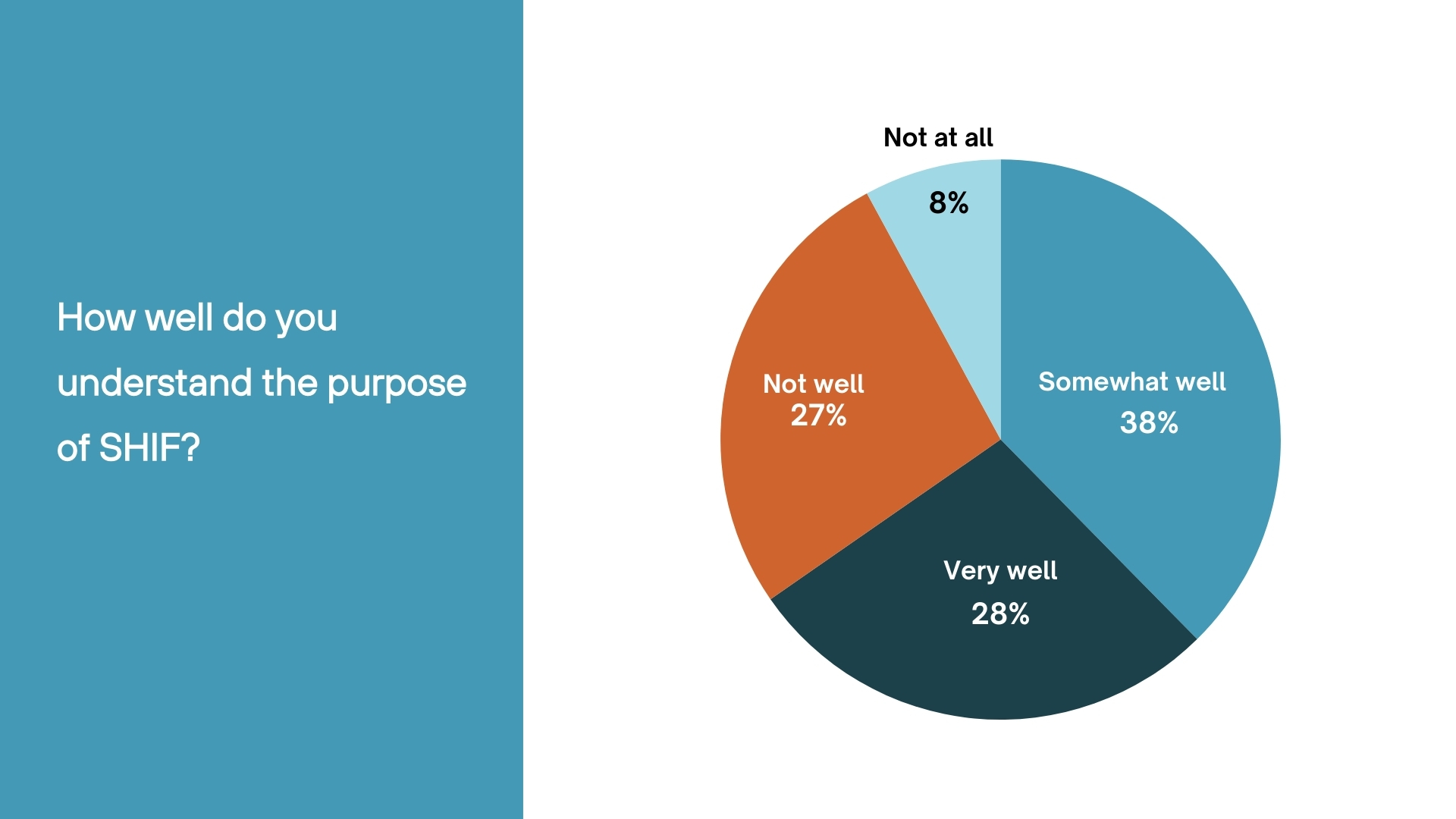
The Goal of SHIF
The survey revealed diverse perceptions about the purpose of SHIF. A significant 35% of respondents believe that SHIF is meant to replace NHIF with a more effective and improved insurance model. Meanwhile, 28% view SHIF as a way to provide affordable health insurance for individuals across all income levels. Additionally, 22% of participants see SHIF as a program designed to offer free healthcare to all Kenyans. However, 10% of respondents were unsure about SHIF’s specific goals, indicating a gap in awareness or understanding.
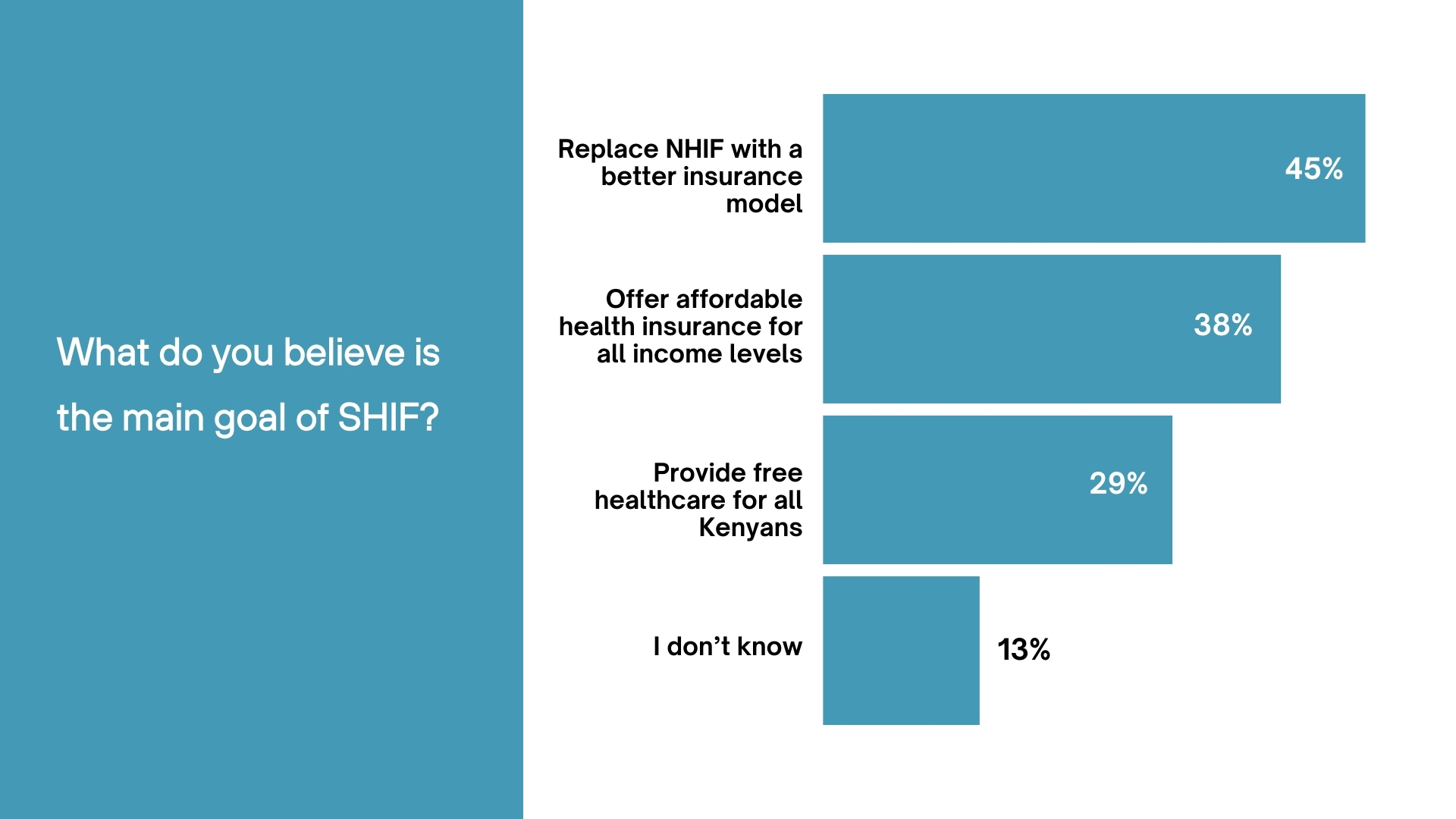
Expectations of SHIF
In this survey, we aimed to understand the participants’ expectations regarding the Social Health Insurance Fund (SHIF). The majority of respondents, 29%, indicated that they have no specific expectations for SHIF. Close behind, 23% expressed positive expectations, showing a hopeful outlook for the fund’s future impact.
Additionally, 13% of respondents are optimistic that SHIF will lead to improved healthcare services, indicating a desire for better quality and more accessible healthcare options. A smaller group, 5%, expects SHIF to outperform the National Health Insurance Fund (NHIF), suggesting a wish for enhanced benefits or increased efficiency. Finally, 4% of participants emphasized the importance of affordability, expressing hope that SHIF will provide health coverage that is financially accessible to a broader population.
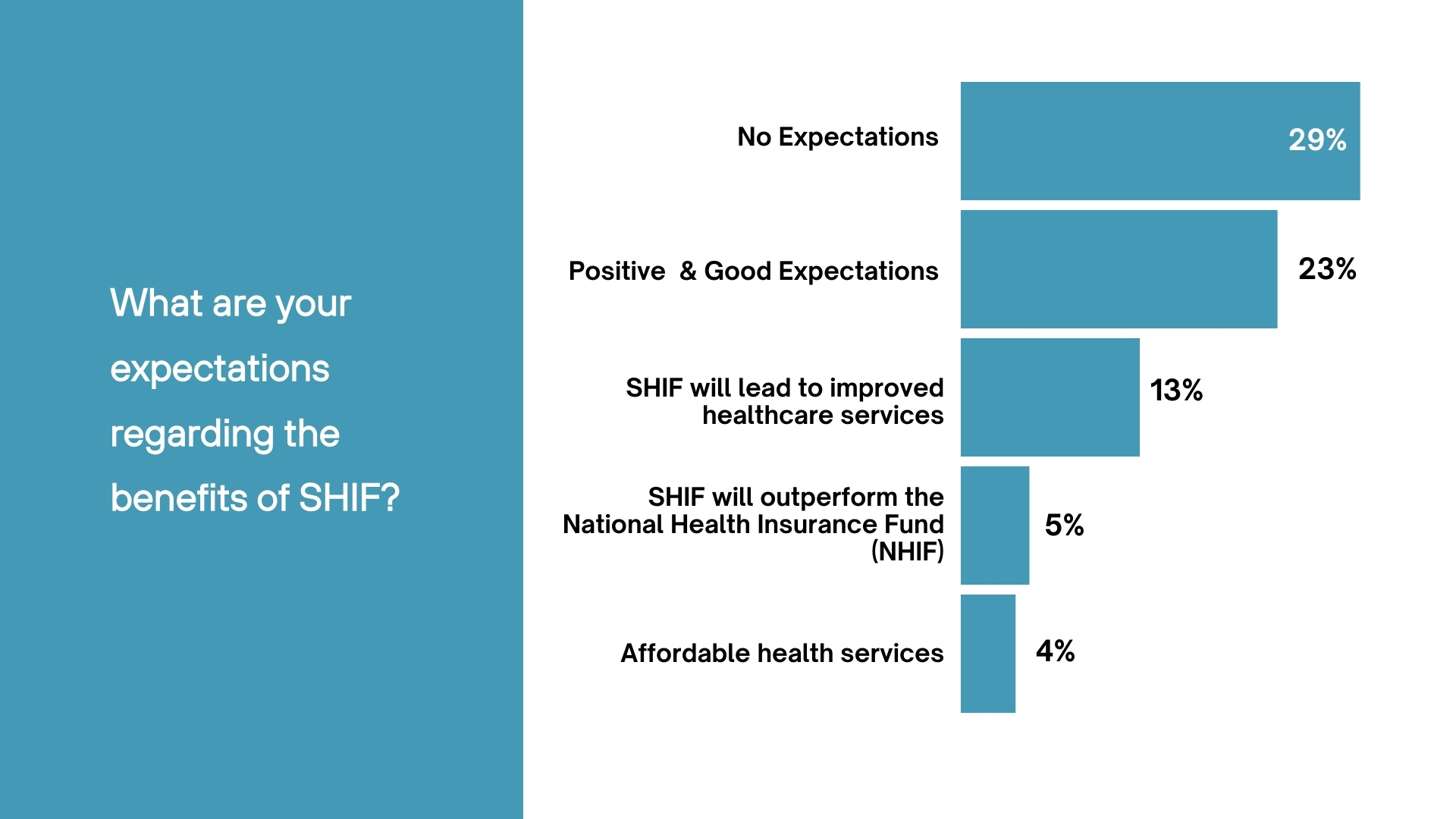
Enrolled to SHIF
According to the survey, 60% of the participants have registered for the Social Health Insurance Fund (SHIF), while 40% have not completed their registration.

Reasons for not registering to SHIF
Among those who have not registered for the Social Health Insurance Fund (SHIF), 34% cited a lack of trust in the system as their primary reason for not enrolling. Additionally, 26% expressed concerns about affordability. Furthermore, 25% mentioned that insufficient information was a barrier to registration, while 19% stated a simple lack of interest. Some respondents (18%) reported facing difficulties during the enrollment process, and 9% preferred private insurance options over SHIF.
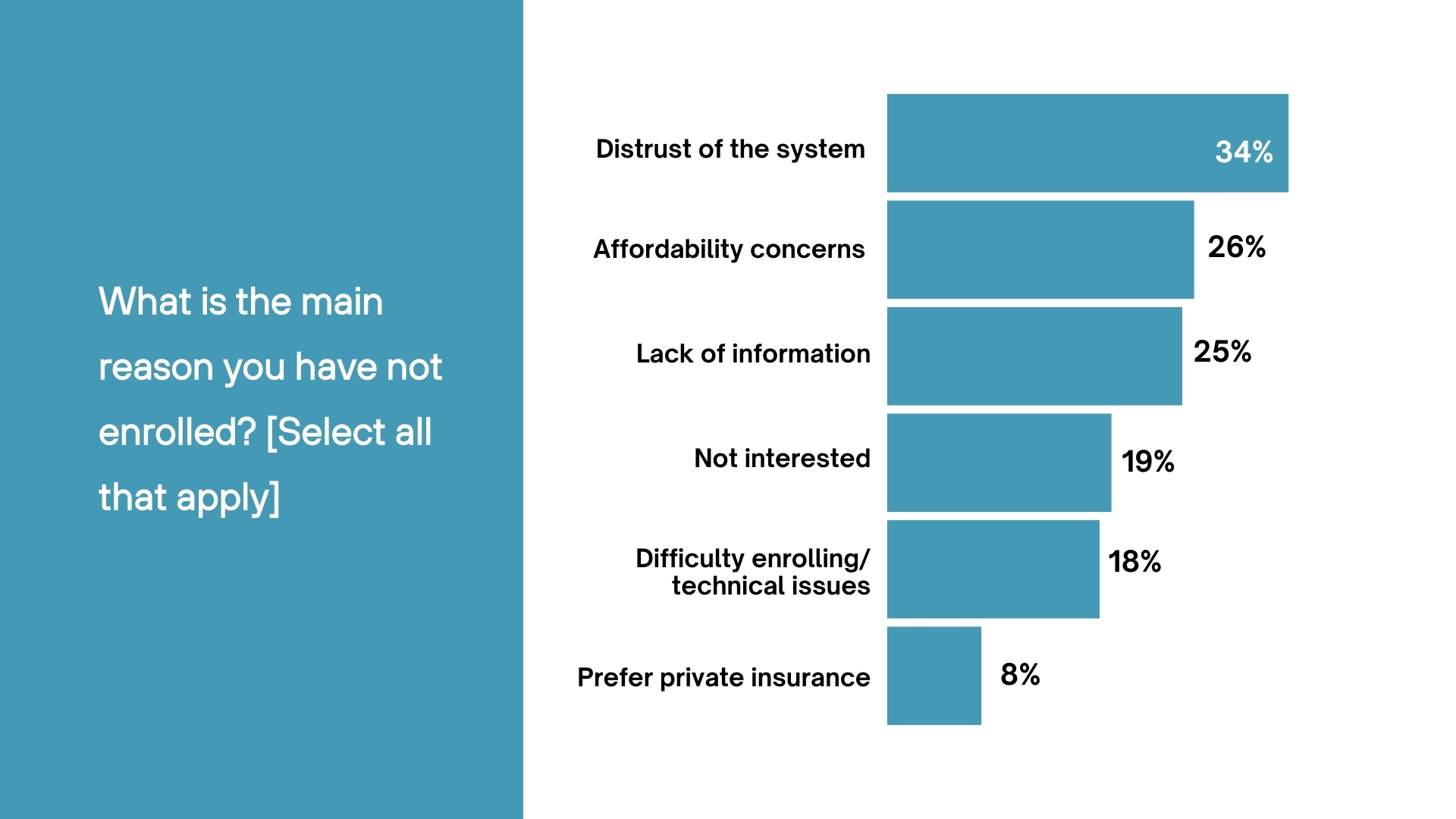
Usage and Experience of SHIF Among Enrolled Participants
Of those enrolled in the Social Health Insurance Fund (SHIF), 63% reported that they have not yet utilized their SHIF coverage, on the other hand, 37% have accessed the new insurance services.
Of those who have used SHIF, the feedback on their experience varies. A notable 29% expressed a neutral experience, indicating neither satisfaction nor dissatisfaction with the services provided. Meanwhile, 23% reported a very poor experience, highlighting concerns or dissatisfaction with the healthcare services or benefits they received.
In contrast, 20% of users shared that their experience was good, suggesting that a portion of enrollees felt their expectations were met. 16% rated their experience as poor, pointing to areas of improvement needed. However, 14% of respondents indicated that their experience with SHIF was very good, reflecting a positive outlook and satisfaction with the services provided.
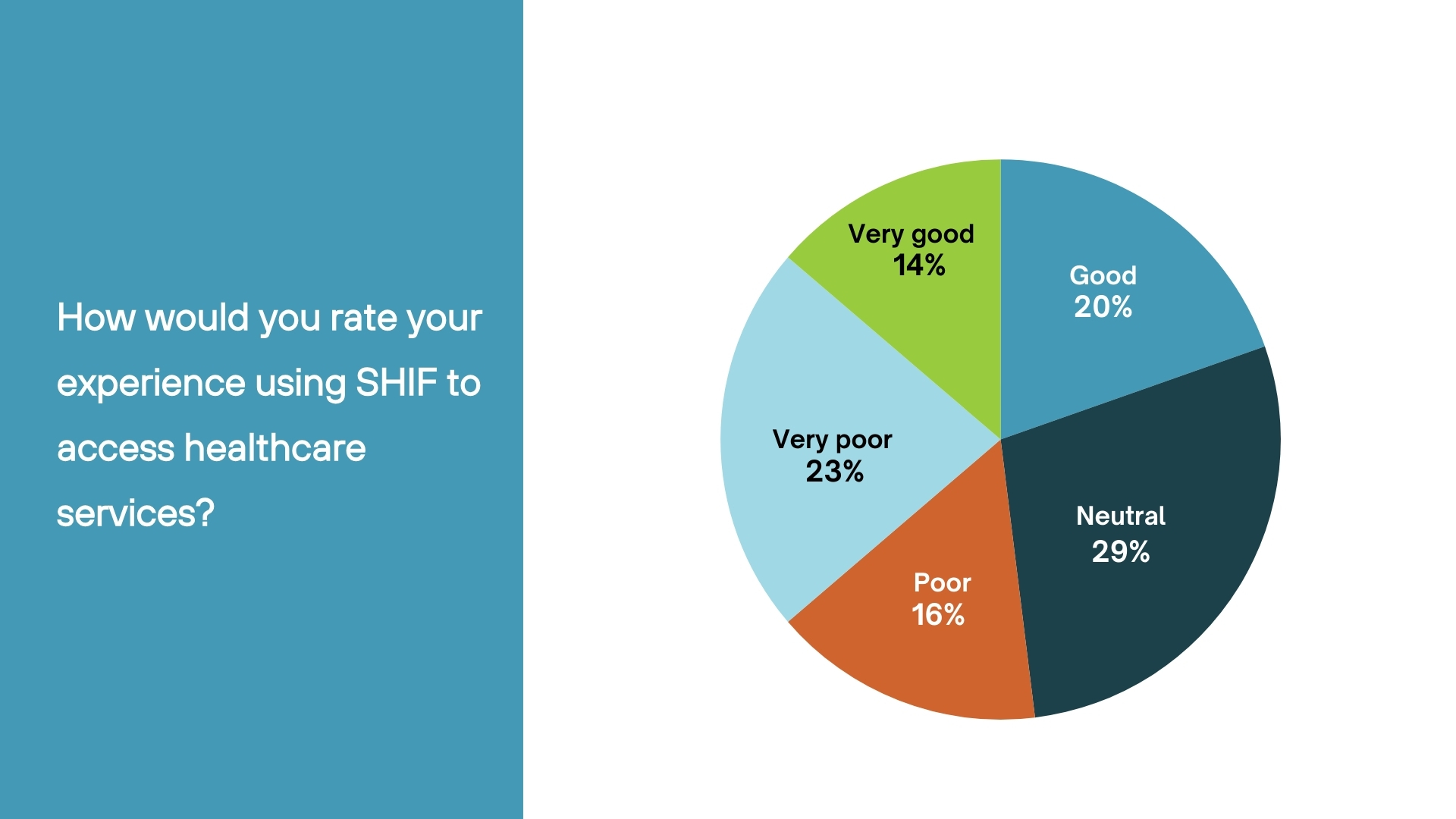
Healthcare services to be prioritized under SHIF
Survey participants identified several healthcare services that should be prioritized under the Social Health Insurance Fund (SHIF). The highest priority was given to emergency medical services, which 70% of respondents highlighted as essential. Following closely were maternity and child health services, valued by 68% of participants. Additionally, 57% emphasized the need for improved management of chronic diseases. General outpatient services and specialized care, such as cancer treatment, were deemed essential by 56% and 54% of respondents, respectively. Furthermore, 40% of participants stressed the importance of preventive care and health promotion, while 39% called for a greater focus on mental health services.

SHIF challenges
The survey identified several key challenges faced by the Social Health Insurance Fund (SHIF). The most significant issue was corruption and mismanagement, which affected 75% of respondents. Limited access to quality healthcare facilities was a major concern for 48% of participants. Additionally, technical and system issues were highlighted by 46% of respondents, while 42% noted a lack of public awareness about SHIF. High costs for members were a worry for 37% of those surveyed, and 34% cited provider reimbursement issues as a significant challenge that disrupts service delivery and overall effectiveness.
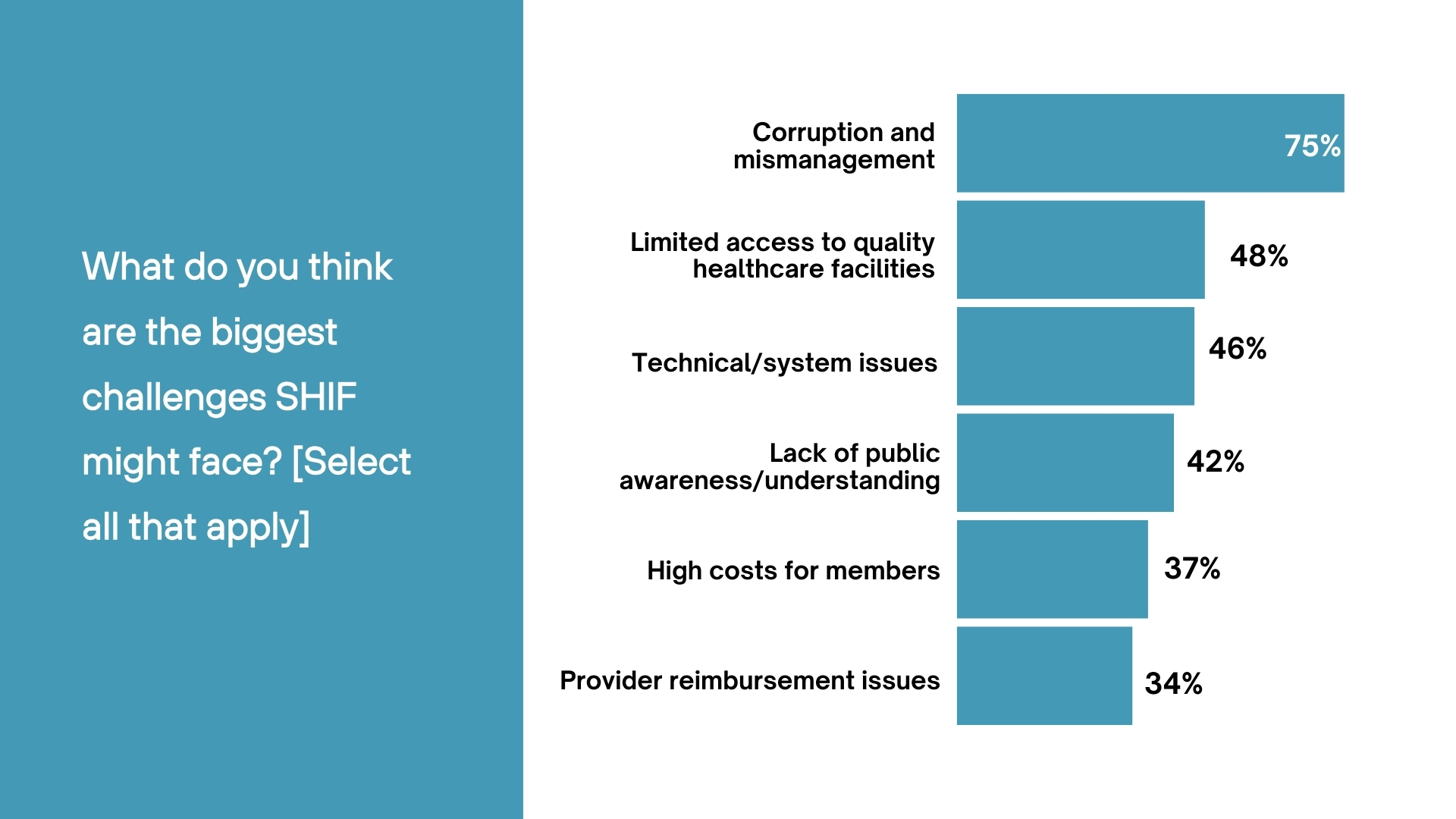
Methodology/About this Survey
This Exclusive Survey was run via the GeoPoll mobile application between the 20th February and 26th of February 2025 in Kenya. The sample size was 961, composed of random GeoPoll app users above the age of 18. Since the survey was randomly distributed, the results are slightly skewed towards younger respondents.
GeoPoll is committed to supporting health organizations, NGOs, and governments in future health challenges. Together, we can use data to inform targeted interventions, mitigate the impact of public health crises, and build more resilient health systems for the future. Our mobile-based surveys offer a unique and tried-and-tested way to gather insights on disease spread, public perception, and vaccine hesitancy, especially in under-resourced regions.
Please get in touch with us to get more details about our capabilities, explore more on healthcare, or other topics in Africa, Asia, and Latin America.
